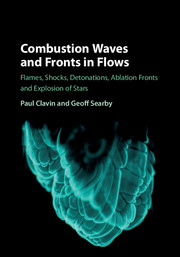 Combustion Waves and Fronts in Flows
Combustion Waves and Fronts in Flows References
Published online by Cambridge University Press: 05 August 2016
- Type
- Chapter
- Information
- Combustion Waves and Fronts in FlowsFlames, Shocks, Detonations, Ablation Fronts and Explosion of Stars, pp. 685 - 703Publisher: Cambridge University PressPrint publication year: 2016


